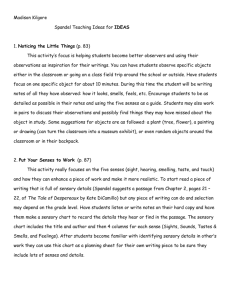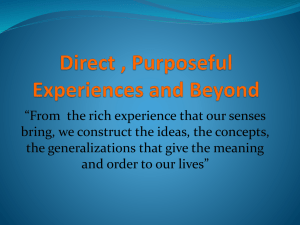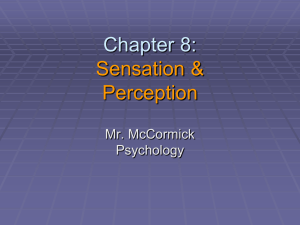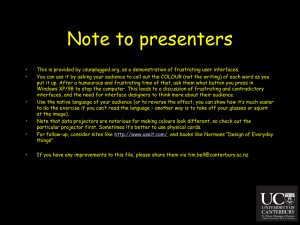Teacher Guide (MS Word format)
advertisement
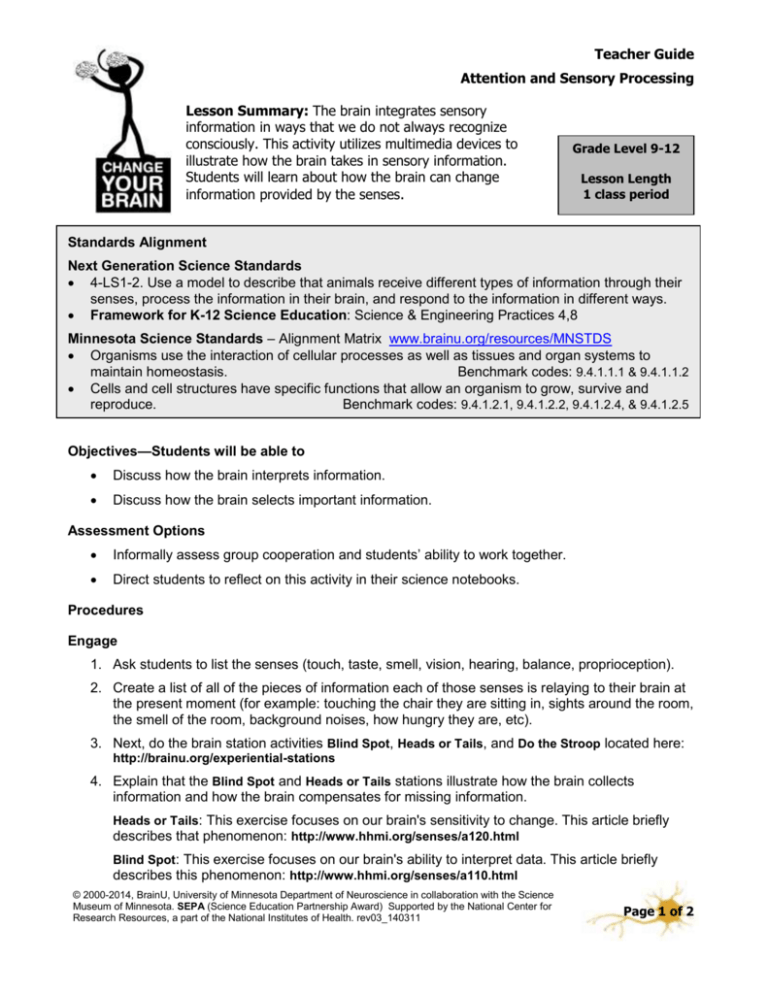
Teacher Guide Attention and Sensory Processing Lesson Summary: The brain integrates sensory information in ways that we do not always recognize consciously. This activity utilizes multimedia devices to illustrate how the brain takes in sensory information. Students will learn about how the brain can change information provided by the senses. Grade Level 9-12 Lesson Length 1 class period Standards Alignment Next Generation Science Standards 4-LS1-2. Use a model to describe that animals receive different types of information through their senses, process the information in their brain, and respond to the information in different ways. Framework for K-12 Science Education: Science & Engineering Practices 4,8 Minnesota Science Standards – Alignment Matrix www.brainu.org/resources/MNSTDS Organisms use the interaction of cellular processes as well as tissues and organ systems to maintain homeostasis. Benchmark codes: 9.4.1.1.1 & 9.4.1.1.2 Cells and cell structures have specific functions that allow an organism to grow, survive and reproduce. Benchmark codes: 9.4.1.2.1, 9.4.1.2.2, 9.4.1.2.4, & 9.4.1.2.5 Objectives—Students will be able to Discuss how the brain interprets information. Discuss how the brain selects important information. Assessment Options Informally assess group cooperation and students’ ability to work together. Direct students to reflect on this activity in their science notebooks. Procedures Engage 1. Ask students to list the senses (touch, taste, smell, vision, hearing, balance, proprioception). 2. Create a list of all of the pieces of information each of those senses is relaying to their brain at the present moment (for example: touching the chair they are sitting in, sights around the room, the smell of the room, background noises, how hungry they are, etc). 3. Next, do the brain station activities Blind Spot, Heads or Tails, and Do the Stroop located here: http://brainu.org/experiential-stations 4. Explain that the Blind Spot and Heads or Tails stations illustrate how the brain collects information and how the brain compensates for missing information. Heads or Tails: This exercise focuses on our brain's sensitivity to change. This article briefly describes that phenomenon: http://www.hhmi.org/senses/a120.html Blind Spot: This exercise focuses on our brain's ability to interpret data. This article briefly describes this phenomenon: http://www.hhmi.org/senses/a110.html © 2000-2014, BrainU, University of Minnesota Department of Neuroscience in collaboration with the Science Museum of Minnesota. SEPA (Science Education Partnership Award) Supported by the National Center for Research Resources, a part of the National Institutes of Health. rev03_140311 Page 1 of 2 Teacher Guide Attention and Sensory Processing 5. Explain how the Do the Stroop station illustrates how the brain selects, manages, and analyzes incoming information Do the Stroop: This exercise focuses on our brain's ability to focus on a task with multiple pieces of information present. Web pages that briefly describe this phenomenon include: http://en.wikipedia.org/wiki/Stroop_effect, http://faculty.washington.edu/chudler/words.html, and http://www.pbs.org/wgbh/nova/everest/exposure/stroopintro.html. The pbs site has an online Stroop test. Explore 1. After instructing the students to be quiet throughout the entire video, present the following YouTube video http://www.youtube.com/watch?v=Ahg6qcgoay4 If you are unable to access YouTube, but have QuickTime, you can utilize this website as an alternative: http://www2.psych.ubc.ca/~rensink/flicker/download/index.html 2. Once the video is over, ask the students if they saw the object first time through. 3. Lead a discussion as to why it was possible to miss the object despite having visual information in plain view. For an explanation, see http://serendip.brynmawr.edu/bb/blindsight.html Optional extra video highlighting this phenomenon (YouTube needed): http://www.youtube.com/watch?v=ubNF9QNEQLA Engage 1. Ask the students to relate the phenomenon in the videos to the phenomenon in the blind spot activity. How are they similar? How are they different? 2. Why does the brain sometimes not register sensory information? 3. What are the benefits of this? What are the disadvantages? 4. What are the implications of this selective sensory processing for how one remembers events? For eye witnesses? © 2000-2014, BrainU, University of Minnesota Department of Neuroscience in collaboration with the Science Museum of Minnesota. SEPA (Science Education Partnership Award) Supported by the National Center for Research Resources, a part of the National Institutes of Health. rev03_140311 Page 2 of 2
